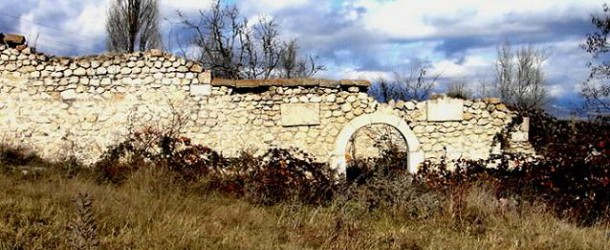Renowned Swiss journalist Andre Widmer has just seen his book titled “The Forgotten Conflict”, dedicated to the Armenia-Azerbaijan, Nagorno Karabakh conflict, published. The book is based on materials compiled by the author during his visit to the occupied territories of Azerbaijan. It provides underpinned by the facts, comprehensive information on the history of the Nagorno Karabakh conflict and its motives, trials and tribulations of Azerbaijanis expelled from their native lands, Khojali genocide, other atrocities committed by the Armenian armed forces in the occupied Azerbaijani territories, illegal settlement policy conducted by the official Yerevan in those areas, and annihilation of our historical, cultural and religious legacy.
The book is especially valuable in conveying the ultimate truth about the Nagorno Karabakh conflict to the international community. Azerbaijani translation of a publication that is certainly to be a fascinating subject for public debate will be presented to our readers in a dedicated series.
Contested Nagorno-Karabakh
Over the centuries, the area that is now Nagorno-Karabakh has had a chequered destiny, belonging alternately to various powers. Early in the 19th century, as a consequence of the third Russo-Persian War, the reigning Khan of Karabakh sought protection from Russia and the Republic of Azerbaijan claimed Nagorno-Karabakh. Under tsarist sovereignty there began a massive wave of new settlement into the region, of primarily Armenians but also Russians, Ukrainians and other ethnicities. The aim was to consolidate Russian dominion by installing a Christian population. It is plausible, however, that a certain number of Armenians before and up until this time were already resident in Nagorno-Karabakh. From the 1830s onwards, the city of Shusha – the economic and cultural heart of Nagorno-Karabakh – developed with two distinct districts: one inhabited by Muslims, the other by immigrant Armenian Christians. In 1905, in the course of clashes between Armenians and Azerbaijanis throughout the Caucasus, Shusha too was host to outbreaks of violence.
After the fall of the Russian tsardom and the disintegration of the short-lived (1918) Transcaucasion Democratic Federative Republic (comprising Georgia, Armenia and Azerbaijan), the three participating nations declared their independence. In 1918 began the first cross-national war between Armenia and Azerbaijan over a number of disputed regions such as Nagorno-Karabakh, Nakhchivan and Zangezur (Syunik). Following the October Revolution, the Soviet Bolsheviks seized control of both countries and decreed that Nagorno-Karabakh and Nakhchivan were to remain with Azerbaijan, while the former Azerbaijani province of Zangezur was to be annexed to the Armenian SSR. The decision to leave Nagorno-Karabakh with Azerbaijan was made by the Soviet Union’s so-called “Caucasus Bureau” on 5 July 1921, in due consideration of historical, geographical and economic commonalities. The mass deportations, which took place during the turmoil of the Ottoman Empire’s collapse, paved the way for Armenian nationalism – already noteworthy at the end of the 19th century – to become radicalised. The fatalities suffered by the Armenians led to a collective self-conception of victimhood, which to this day is deeply engrained in the psychology of the people. Armenian nationalism endured throughout the Soviet era and as a result, many Azerbaijanis were compelled to emigrate from their homeland Zangezur during this period.
As of 1975, the extreme Armenian terrorist organisation ASALA (the “Armenian Secret Army for the Liberation of Armenia”) commenced its actions abroad. The militant group, composed primarily of exiled Armenians, was dedicated to “liberating” the former Armenian regions of present-day Turkey. Attacks in various European countries and in North America claimed numerous victims. One of the ringleaders, Monte Melkonian, later died while fighting in Nagorno-Karabakh, in 1993. Extremist Armenian groups were eventually also involved in bomb attacks in Azerbaijan, in connection with the independence movement of the Armenians in Nagorno- Karabakh.
The igniting spark
As Soviet power eroded towards the end of the 1980s, Armenian nationalism grew stronger. This sense of national pride goes some way to explaining the first armed altercations before the start of the Nagorno-Karabakh War. The German political scientist Heiko Langner identifies what is described as little more than a “trifle” as being the catalyst for the conflict; the Armenian residents of the Nagorno-Karabakh village Chardakli refused to accept an Azerbaijani as leader of a sovkhoz. This piece of news spread like wildfire, reaching as far as Yerevan in Armenia, where a mass demonstration planned by the opposition as an environmental protest morphed into a rally in favour of “Reunification with Artsakh” (Artsakh is the Armenian name for Nagorno-Karabakh). The first fatalities to follow in Nagorno-Karabakh were Azerbaijanis. By 1987 there were already efforts underway in Armenian Yerevan to annex to the Armenian SSR the Nagorno-Karabakh Autonomous Oblast, which belonged up to this point to the Azerbaijani Soviet Socialist Republic. On 20 February 1988, the Armenian-characterised regional parliament in Nagorno-Karabakh passed a resolution in favour of unification with Armenia (at the time, the region’s population comprised 73.5 per cent Armenians and 25.3 percent Azerbaijanis). Following the resolution, as rumours circulated regarding the death of an Azerbaijani, Azeri civilians from Agdam set off on the road to Stepanakert/Khankendi to seek answers.
The Azerbaijanis were unarmed; the non-government affiliated journalist Aynur Elgunesh, whose cousin was a member of this group in 1988, confirms this. Clashes with ethnic Armenians in Askeran on 22 and 23 February 1988 resulted in the deaths of two Azerbaijanis. On 12 July 1988 the Nagorno-Karabakh Armenians declared their exit from the Azerbaijani SSR. In the meantime, the Soviet interior ministry took over control of the mountainous region. An attempt by Soviet forces in May 1991 to disarm the Nagorno-Karabakh Armenians was, however, unsuccessful. The declaration of independence from Armenia and Azerbaijan in 1991 and Nagorno-Karabakh’s unilateral declaration of independence on 6 January 1992 led to an escalation of the conflict into open warfare.
In Armenia, the Communists were swept from power and the country assembled its own national army. Meanwhile, Azerbaijan sank into domestic political turmoil and the formation of its armed forces suffered a crucial delay. The Armenian army then fell into step with the Nagorno-Karabakh Armenian separatists, who began to drive out the inhabitants of ethnic Azerbaijani villages with armed force. A peaceful settlement was nevertheless almost reached in autumn 1991. The presidents of Russia and Kazakhstan brokered an agreement on territorial integrity, non-intervention in internal affairs and the monitoring of human rights. Then on 20 November, a helicopter carrying a high-ranking peacemaking group composed of Russians, Kazakhs and Azerbaijanis was shot down over Nagorno-Karabakh.
This, along with the Armenians’ refusal to resume peace talks, resulted in a further escalation. Early in 1992 the Armenians, with the support of scattered sections of the Russian Army’s 366th Motor Rifle Regiment, which had remained in the region, intensified their attacks on ethnic Azerbaijani settlements within Nagorno-Karabakh. Most notorious was the massacre of the population of Khojaly, a town near Stepanakert/Khankendi, on 25 and 26 February. According to Azerbaijani accounts 613 civilians were killed, including many women and children. Current Armenian president Serzh Sargsyan, who at the time fought as a commandant in Nagorno-Karabakh, was quoted in Thomas de Waal’s book “Black Garden” as follows, “Before Khojaly, the Azerbaijanis thought that Armenians were people who could not raise their hands against civilians. We were able to break this ‘stereotype’.”
On 8 May in the same year, the Azerbaijani stronghold of Shusha fell. This Armenian victory made way for the finale in the ethnic cleansing of Nagorno-Karabakh. A few days later, Armenian units succeeded in capturing Lachin, a 99 per cent Azerbaijani-inhabited region lying outside of Nagorno-Karabakh and thus outside the area to which they laid claim, but through which runs the only connecting road between Armenia and Nagorno-Karabakh. The Azerbaijanis were expelled from Lachin. A large-scale Azerbaijani counteroffensive brought only limited and short-lived successes. Within a few months, the Armenian separatists conquered the districts of Kalbajar, Agdam, Fizuli, Jabrayil, Qubadli and Zangilan – all of which lie outside Nagorno-Karabakh – and again drove out the Azerbaijani civilian populations. The Azerbaijanis managed nonetheless in 1993 and 1994 to free parts of the provinces Fizuli and Agdam. On 12 May 1994, a ceasefire agreement was finally signed. It is estimated that 25,000 to 30,000 people lost their lives to the war, with another 25,000 wounded. Azerbaijan now records one of the highest refugee rates in the world. Mediation attempts by the OSCE and meetings organised by Russia have not yet led to a peace treaty. Despite the accord of 1994, incidents of gunfire and fatalities continue to take place along the ceasefire line.
Andre WIDMER
























































